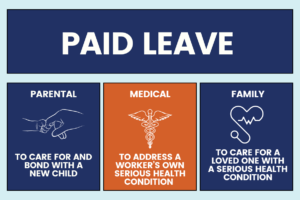How can paid leave support workers and their families?
Paid leave would enhance the economic well-being of Arizona’s workers and their families.
Workers without paid leave are most likely to experience financial hardship. The wage data above shows that workers with the lowest incomes have the least access to paid leave. Women tend to earn lower wages when they experience gaps in their careers. In fact, the median wage for women in Arizona in 2023 is lower than that of men a decade ago. A paid leave program would allow more women to advance in their careers.
“Years ago when I was a single mom, I went to work while I was sick because if I took time off, I would not have enough money to pay rent.” – Elevate Her event participant
With more opportunities to make progress in a job, parents will have less stress and could help reduce the number of children who have an adverse childhood experience. The 2024 KidsCount Data Book reports 43 percent of children in Arizona have experienced one or more childhood experience compared to 40 percent nationally. Prevent Child Abuse America provides resources about paid family leave in recognition that such benefits are a “significant lever for preventing early childhood maltreatment.”
Paid leave would reduce health issues for children, older adults and people with disabilities.
The benefits that paid leave creates for the health of parents and children – from mental health to less rehospitalizations and more – are clear. Researchers say that without quality initial bonding time between a parent and a newborn, the child is less likely to become a happy, independent and resilent adult. Paid leave has also been found to reduce infant mortality rate.
Caregiving costs skyrocketed after the COVID-19 pandemic due to a shortage of direct care workers. This increased the value of unpaid caregiving from family members to $18.20 per hour in Arizona. A paid leave program would allow more older adults and people with disabilities to receive care at home from their family.
How can paid leave support businesses?

Paid leave helps businesses retain quality employees and reduce turnover costs.
A significant share of prime-aged adults, people ages 20 to 54, who are not in the labor force largely cite the lack of paid leave as the reason for leaving their last job. The costs of replacing an employee can be significant with one study finding that the median cost of replacing a departing employee is 21 percent of that employee’s salary.
“I had to find a new job that was “child” friendly and could accommodate my needs as a new mom.” – Elevate Her event participant
In an already tight labor market, employers are having to replace employees that would have stayed but for the lack of paid leave. These additional hiring and training expenses are impacting businesses’ bottom lines at a time of rising capital and labor costs and high interest rates.
Paid leave improves productivity, employee morale, and profitability.
Access to paid leave has been reported to improve productivity, employee morale, and even profitability. One study found that employers that created or expanded their paid leave programs saw an average increase in profit per full-time employee of 6.8 percent.
How can paid leave support the economy?
Paid leave will increase Arizona’s labor force participation rate, boost Arizona’s gross domestic product (GDP), and provide a broader tax base to support public investment in schools, housing, and transportation and water infrastructure.
Women disproportionately take on unpaid caregiving responsibilities. In Arizona, the labor force participation rate of women has still not recovered since the pandemic as many women remain out of the workforce due to caring for a child or an ill family member.
Access to paid leave can keep workers at their current employer and incentivize non-working adults to re-enter the workforce. When women are offered paid leave, they are far more likely to remain in the workforce 10 years later as compared to women who are only offered unpaid leave or no leave at all.
Providing paid leave is good economics. When the labor force participation rate is higher, the GDP will rise as more people are producing goods and services in the economy. Consequently, this additional economic output will result in additional tax revenue to invest in public policies that promote future economic growth.
Arizona experienced a severe shortfall in revenue in 2023 and the first part of 2024 because of a series of tax cuts passed in 2021. Additionally, it has become more difficult to raise taxes in Arizona, which means that the state needs to broaden the base to raise additional revenue.
Access to paid leave is an equitable policy that will increase the labor force participation rate and lead to increased tax revenue for Arizona. This policy will not only support workers and families but allow Arizona’s economy to continue to thrive.



